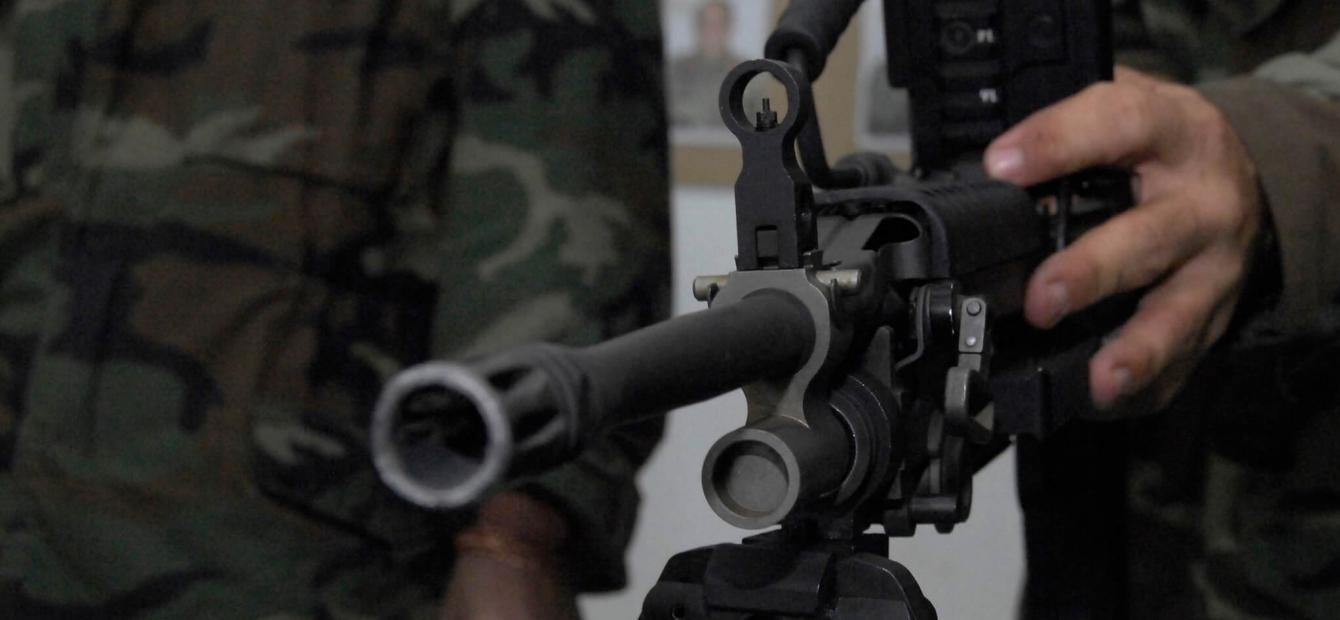
The past and future of Afghan warlords
Regardless of how Afghanistan’s very uncertain situation unfolds, warlords are here to stay. In the second episode of the Dutch series '20 years after 9/11’, Romain Malejacq explains the resilience of Afghan warlords and their role in post-NATO Afghanistan.
Last April, United States’ president Joe Biden announced the full withdrawal of American troops from Afghanistan to be completed by the 20th anniversary of the 9/11 attacks on New York and Washington D.C. Within two months of this announcement, the Taliban had intensified their offensives against Afghan government forces and captured over a hundred additional districts.
This eventually caused Marshal Abdul Rashid Dostum, the infamous warlord of northern Afghanistan, to react. On 27 June 2021, Dostum pledged to return to his home province of Jowzjan to lead the fight against the Taliban.1
This is not idle talk. During his time as vice president (from 2014 to 2020), Dostum took the initiative to coordinate the war in northern Afghanistan twice, turning his Jowzjan palace into a command centre, causing consternation as well as concern among both Afghan and Western military establishments. Back then, he was the second-ranking official of the Islamic Republic of Afghanistan. But today, he holds no official position in the government.

Dostum’s behaviour suggests that men like him (they are almost always men) are not mere challengers to the state. They represent alternative forms of authority that are well suited to certain circumstances (at times better suited than states) and constantly adapt to new environments.
I define warlords as astute political entrepreneurs with a proven ability to organise violence and control territory
These men’s resilience over the past four decades shows that warlords are here to stay, regardless of how Afghanistan’s very uncertain situation unfolds. What role, then, is there for people like Marshal Dostum in post-NATO Afghanistan? How will they adapt to yet another change in their politico-military environment?
The power of warlords
Men like Dostum are what I call ‘warlords’. The term often carries a strong pejorative undertone, but it does depict an empirical reality. I use the term, but adopt a definition that is detached from normativity and focuses on what these men do rather than what is assumed of them.
In my recently published book, Warlord Survival: The Delusion of State Building in Afghanistan2 , I define warlords as astute political entrepreneurs with a proven ability to organise violence and control territory. They exert and transform authority across different spheres (ideological, economic, military, social and political) and at different levels of political affairs (local, national and international).
These individuals persist – during and after war – due to their ability to make themselves indispensable at these different levels of politics and to exploit the gaps and interactions between them. They survive because there is a demand for people who can organise violence and provide trust, security and employment along the way, at these different levels.
The mujahideen commanders later participated in the warlord politics of the 1990s
Not only do warlords remain influential in the political system – to the point of becoming first vice president, for example – but they also hold power that goes far beyond simple military might and endures long past the moment they have ceased to command a credible force. When the pressure of state centralisation prevents them from exerting military power and controlling territory, they transform, adjust and bide their time. They shape-shift and instrumentalise what Westerners perceive as social disorder to ensure their survival in a changing political environment.
Warlords throughout history
To understand the resilience of Afghan warlords, we need to go back to the beginning of the Afghanistan wars. After coming to power in a coup in April 1978, the pro-Soviet People’s Democratic Party of Afghanistan (PDPA) soon faced uncoordinated uprisings across the country. This eventually resulted, in December 1979, in the Kremlin’s desperate attempt to steer and save the regime through military invasion.
A resistance movement quickly organised itself around a few political parties and their leaders, exiled in Iran and Pakistan. These leaders gathered external support, funding and military equipment, which they then redistributed to their commanders, dispersed throughout the Afghan territory and fighting a jihad against the Soviet Union on their behalf.
It is these mujahideen commanders – and their pro-government counterparts, such as Dostum – who later participated in the warlord politics of the 1990s. They progressively established their grip over entire regions while increasing their autonomy vis-à-vis their party (or, in the case of pro-government militia leaders, vis-à-vis the central state).

On 14 April 1988, the Geneva Accords acknowledged the withdrawal of all Soviet troops from Afghan territory (completed the following February). Contrary to expectations, the PDPA regime survived over three years after the departure of the last Soviet troops. It ultimately fell in April 1992, a few months after Moscow cut off all supplies, following the collapse of the Soviet Union in December 1991.
The mujahideen – and former pro-government commanders, like Dostum, who had eventually joined them – took control of Kabul. The Afghan capital rapidly became the scene of intense combat and ever-shifting alliances. Some commanders captured what was left of the state infrastructure; others focused on expanding their zones of influence in the provinces.
This situation led to a progressive concentration of power and the emergence of regional polities run by warlords, who started ruling autonomously over significant parts of the Afghan territory. These warlords established access to capital (through international patronage networks) to wage war more effectively, defeat rivals and extend territorial control.
They sustained state-like administrative systems, schools and hospitals, until they were defeated by the Taliban and had to abandon their strongholds. Some spent years in exile; others joined the United Islamic Front for the Salvation of Afghanistan, the anti-Taliban resistance (better known as the Northern Alliance), operating from Tajikistan and northeastern Afghanistan – the only area in the country that still escaped Taliban control.
After 9/11: the US in Afghanistan
Things changed again with the beginning of the US-led intervention in 2001. Teams of CIA operatives were sent to Afghanistan in the immediate aftermath of 9/11 to connect with the main Northern Alliance commanders. They were soon followed by special operation forces sent to coordinate air support, using the Northern Alliance fighters as proxies on the ground (and creating lasting personal relationships with them).
The operation, aimed at toppling the Taliban regime, was a tremendous military success. Within weeks, Taliban forces were expelled from key cities around the country, including Kabul, causing the regime to collapse as warlords and their fighters secured the provinces. Together with two dozen power holders and exiled political actors, these warlords (or their representatives) were then invited to the International Conference on Afghanistan (the first of many), held under UN auspices in Bonn (Germany) at the end of 2001, to decide on the country’s political future.3
Hamid Karzai, a tribal leader from southern Afghanistan, was appointed chairman of the Interim Authority4 , cabinet positions were distributed among the participants and their allies (in particular to Northern Alliance representatives)5 , and a NATO-led military mission – the International Security Assistance Force (ISAF) – was deployed to Afghanistan.

The sudden infusion of resources that came with the US-led intervention, along with the collapse of the Taliban regime, allowed warlords to reform their old polities in the provinces and to work hand in hand with US special operations forces. Washington’s focus on short-term stability and the ‘Global War on Terrorism’ in the first years of the intervention actually encouraged these men to fill the security vacuum left by the defeat of the Taliban (especially as ISAF was initially limited to securing Kabul only) and take control of regional and national state institutions.6
Without an army he could mobilise (unlike the warlords), Hamid Karzai had little choice but to acknowledge the warlords’ authority rather than challenging them. For instance, by appointing warlords as governors in the provinces they controlled.
The situation evolved around 2004, as most in the administration of President George W. Bush believed the victory over the Taliban to be secured. Warlords were soon deemed incompatible with the state that the international community was trying to build.
Western policymakers started to impose what former US ambassador to Afghanistan Zalmay Khalilzad – who later oversaw the US-Taliban peace deal of February 2020 – considered to be new rules of the game. These rules aimed at bolstering state authority while co-opting the most dominant warlords, hence depriving them of territorial control.
Warlords had to develop more subtle strategies to remain indispensable
On top of that, these new rules increased the state’s resources while decreasing those of the warlords, not least by centralising custom revenues. This state centralisation process, in combination with disarmament, demobilisation and reintegration programs, a broader security sector reform and a general attempt at establishing so-called good governance, forced the warlords to give up their military power (and territorial control).
The warlords had no alternative but to become more discreet, and rely on resources more adapted to the new environment. For example, distributing some of the land that their fighters had grabbed to invest in real estate development, thus converting military power into economic power.
Warlords had to develop more subtle strategies to remain indispensable. They had to reinvent themselves, for instance, by becoming businessmen, ministers or governors. Yet the warlords always maintained their ability to shape-shift and take up arms, if needed.
The situation started to change once again on the eve of the Afghan presidential election in 2009. The tensions between Karzai and the international community led the president, in need of local power holders able to deliver votes, to call on the main warlords. These warlords, in turn, took advantage of the conflicting agendas of domestic and foreign actors to promote their interests.
With the growing influence of the Taliban insurgency and the announced departure of US troops (originally scheduled for 2014), political dynamics radically changed. In those years, the growing ambiguity of the international community’s intentions in Afghanistan created a high level of domestic uncertainty, leading warlords to switch their power bases once again and increasingly invest in their military power. Warlords started to remobilise and rearm their followers, even though the US – in fear of a repeat of what happened in Iraq with the collapse of the national army and the rise of the self-proclaimed Islamic State – eventually maintained troops for a few more years.
What happens now?
In my book, Warlord Survival, I explain that we should expect warlords to react to a sharp decline in state resources (accompanied by a weakening of the state’s ability to control its territory) by attempting to reacquire military power. This is how we should interpret Dostum’s announcement to return to his home province of Jowzjan to lead the fight against the Taliban. With the end of NATO operations, the departure of all US and NATO forces and the Taliban gaining momentum on the battlefield, the demand for trust and security emanating from ordinary Afghans is higher than ever.

People are now taking up arms against the Taliban. They will certainly stand by their leaders as uncertainty persists and violence increases, relying on those who can actually protect them. International actors will also be in need of what warlords can provide (information, fighters, etc.), as they try to keep the Taliban and other groups – the Islamic State Khorasan in particular – under control.
Warlords represent important elements of political continuity. Given that they managed to stay relevant in the height of a state-building project that aimed at getting rid of alternative forms of authority and governance, there is no reason to believe they will disappear now that the state is weakening and losing its ability to control territory.
On the contrary, warlords will play an active role in the future of Afghanistan. They will remain businessmen and political leaders, connected to global economic processes and networks. They will develop the military power that they need to control territory and wage war. They will, finally, continue to fight for more autonomy and, in some cases, might even manage to partially form their old regional polities once again.
Whether the central government manages to hold its own and resist the Taliban or not, post-NATO Afghanistan is likely to feature a patchwork of overlapping, competing, political orders between the state, the Taliban, the warlords and other non-state armed actors – something resembling Afghanistan of the 1990s. Whatever happens in Afghanistan in the next few years, warlords will be involved. Warlords are part of Afghanistan’s political fabric, and they are here to stay.
- 1‘Dostum Vows to Return to North, Suppress Taliban’, TOLOnews, 27 June 2021.
- 2Romain Malejacq, Warlord Survival: The Delusion of State Building in Afghanistan, Ithaca, NY: Cornell University Press, 2019.
- 3Participants to the so-called Bonn Conference were divided into four groups: the Northern Alliance, the largest and most powerful group (to whom the warlords or their representatives belonged); the group of Rome, the second largest group, made of supporters of former King Zahir Shah (deposed in 1973 and since exiled in Italy); and the Peshawar and Cyprus groups, made of exiles supported by Pakistan and Iran respectively.
- 4The participants decided that, after six months, the Interim Authority would be followed by a two-year Transitional Authority, before the holding of presidential elections. They also agreed that a grand council regrouping the country’s main political actors and power holders (a loya jirga) would be convened within that transitional period to adopt a new constitution.
- 5For instance, the Defense Minister, the Foreign Minister, and the Interior Minister appointed in Bonn all belonged to the Northern Alliance.
- 6ISAF was progressively expanded to the entire country in the following years.






0 Comments
Add new comment